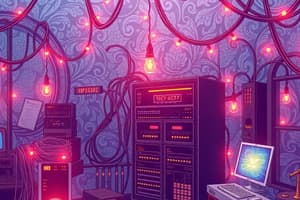Podcast
Questions and Answers
What is the function of a Network Interface Card (NIC)?
What is the function of a Network Interface Card (NIC)?
Enables a device to connect to a network
What is the purpose of a Firewall in a network?
What is the purpose of a Firewall in a network?
Monitor and control network traffic based on security rules
What is the main role of Network Attached Storage (NAS) devices?
What is the main role of Network Attached Storage (NAS) devices?
Provide centralized storage and file sharing services
What is the primary function of Fiber Optic Cables in network communication?
What is the primary function of Fiber Optic Cables in network communication?
What is the purpose of color coding in Ethernet cables?
What is the purpose of color coding in Ethernet cables?
What are the basic steps involved in crimping Ethernet cables?
What are the basic steps involved in crimping Ethernet cables?
At which layer of the OSI model do routers operate, and what is their primary function?
At which layer of the OSI model do routers operate, and what is their primary function?
How do switches differ from hubs in terms of their operation and efficiency?
How do switches differ from hubs in terms of their operation and efficiency?
What is the primary function of a modem, and how does it facilitate communication between a computer/network and an external network?
What is the primary function of a modem, and how does it facilitate communication between a computer/network and an external network?
Explain the purpose of an access point (AP) in a network environment.
Explain the purpose of an access point (AP) in a network environment.
Describe the primary difference between the operation of a router and a switch within a network.
Describe the primary difference between the operation of a router and a switch within a network.
Explain why hubs are considered less efficient than switches in a network environment.
Explain why hubs are considered less efficient than switches in a network environment.
Flashcards are hidden until you start studying
Study Notes
Network Interface Card (NIC)
- A hardware component that enables a device to connect to a network
- Provides the physical connection between the device and the network medium
Firewall
- A device or software that monitors and controls incoming and outgoing network traffic
- Acts as a barrier between a trusted internal network and untrusted external networks
Network Attached Storage (NAS)
- A specialized storage device that provides centralized storage and file sharing services
- Often used for backups, file sharing, and multimedia streaming within a network
Network Cables and Connectors
- Ethernet Cable (Twisted Pair): most common type of network cable used in LANs
- Fiber Optic Cable: uses light signals to transmit data, offering high bandwidth and resistance to electromagnetic interference
- Coaxial Cable: consists of a copper conductor surrounded by insulation and shielding, commonly used in cable TV networks and broadband internet connections
Color Coding (Twisted Pair Ethernet Cables)
- T568A standard: specific color coding for Ethernet cabling
- T568B standard: alternative color coding for Ethernet cabling
Crimping Ethernet Cables
- Involves attaching connectors to the ends of Ethernet cables
- Basic steps: strip the outer jacket, untwist and arrange the wires, trim the wires, insert into the RJ45 connector, and crimp the connector
Network Hardware Devices
- Router: connects multiple networks together, routes data packets between them, and operates at the network layer (Layer 3) of the OSI model
- Switch: connects multiple devices within a LAN, operates at the data link layer (Layer 2) of the OSI model, and uses MAC addresses to forward data
- Hub: connects multiple devices within a LAN, operates at the physical layer (Layer 1) of the OSI model, and broadcasts data to all connected devices
- Modem: modulates and demodulates digital signals to enable communication between a computer or network and an external network
- Access Point (AP): allows wireless devices to connect to a wired network
Studying That Suits You
Use AI to generate personalized quizzes and flashcards to suit your learning preferences.




